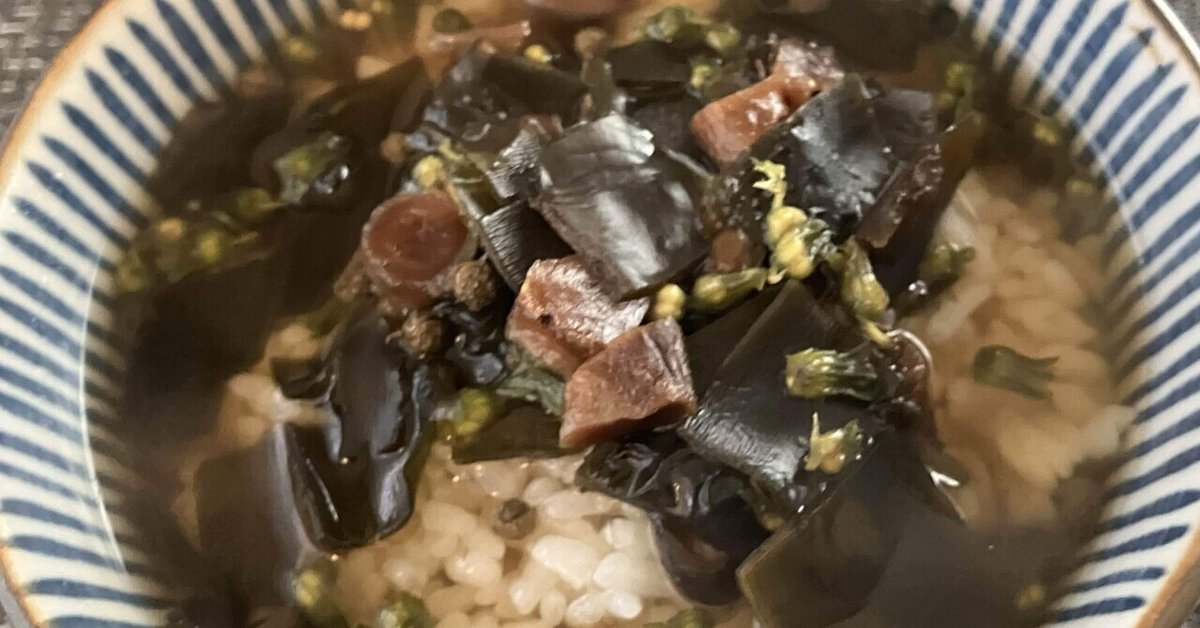
〆の茶漬けと荏胡麻の実の塩漬け Late-night ochazuke and salted perilla seeds :おまかせ小品集 Chef's choice dishes collection
深夜食堂(ドラマの深夜食堂よりずっと前のお話)」でお出しした料理の小品集。材料がある限り何でも出してました。ほとんど即興だったので何百種類も作りましたが、お客様のエピソードを思い出せるものを少しづつ再現します(差し支えある話は多少脚色しています)。
A collection of small dishes served on "Midnight Diner" (a story that took place long before the TV drama "Midnight Diner"). We served anything as long as we had the ingredients. Since it was mostly improvisation, we made hundreds of dishes, but we will recreate little by little the ones that remind us of our customers' episodes (we have dramatized some of the more inappropriate stories).
おまかせの時間
The inspiration for the recipe
もう、故人になってしまわれたが、とある大学の名誉教授のお客様がおられた。専攻はドイツ文学。僕はかつてドイツ語圏でコンピュータの仕事をしていたこともあって、気に入ってくださったのか、彼は良くドイツの思い出話をしに深夜に僕の所に寄ってくれた。大酒飲みで、何軒もの飲み屋を梯子した上での僕の居た深夜バーが〆の拠り所で、僕が彼のために帰宅のタクシーを呼ぶのが恒例だった。
彼の話はとても面白く、大学教授という人種の割には全く偉ぶったところのなく、いつもこちらが楽しませてもらった。外国文学の先生でも、外国語会話はあまり得意でない先生も多い。彼はかなりの例外で、ドイツで学生時代を過ごしネイティブに近い流暢なドイツ語を喋っていた。そんな経歴もあってか、良くドイツやオーストリア、スイスからの友人を連れて来てくれた。散々日本料理屋に連れて歩いて、彼の友人たちが日本料理を食べ飽きたかなというタイミングで、僕のところに連れて来て、僕にワインに合わせたドイツ人が好きそうなおつまみを作らせるのだった。前もって自家製のソーセージやアイスバインを仕込んでおいてくれ、といったサプライズを狙った依頼もあって、お客様をもてなすのに用意周到な方でもあった。彼にはちょっと年上の奥様がいらしゃって、外国のお客様を連れて来た時には、大抵奥様もご一緒だった。とても笑顔の素敵な方で、旦那さんと同じでとても社交的だった。僕と同郷で、彼女の柔らかい京都弁が大好きだった。お二人ともかなり長寿だったのだけど、残念ながら奥様が先にお亡くなりになった。
I had a guest who was a professor emeritus at a certain university, but he has passed away. He majored in German literature. I used to work in computers in a German-speaking country, so he must have liked me, and he would often stop by my place late at night to talk about his memories of Germany. He was a heavy drinker, and would hit up a number of bars before finishing off his night at the late-night bar where I was, and it was customary for me to call him a taxi to go home.
His stories were very interesting, and for a university professor, he was not at all arrogant, so I always enjoyed talking to him. Many foreign literature professors are not very good at speaking in foreign languages. He was quite an exception, having spent his student days in Germany and speaking fluent German, almost native. Perhaps because of his background, he often brought friends from Germany, Austria, and Switzerland. After taking them to many Japanese restaurants, when his friends seemed to be tired of eating Japanese food, he would bring them to me and ask me to make snacks that Germans would like to go with the wine. He also asked me to prepare homemade sausages and Eisbein in advance as a surprise, and he was very careful about how he entertained his guests. He had a wife who was a little older than him, and when he brought foreign guests, she was usually with him. She was a lovely woman with a great smile, and like her husband, she was very sociable. She was from the same hometown as me, and I loved her soft Kyoto dialect. They both lived long lives, but unfortunately his wife passed away first.
それからも彼の夜の飲み屋徘徊生活は変わらず、前と同じように僕が彼のためにタクシーを呼ぶ儀式も変わらなかった。彼は一人で来る時はあまり食事はせず、ワインに合わせてチーズやオリーブを食べるくらいだった。
ある夜、お客さんが切れて、僕が賄いを食べている時に彼が現れた。彼は僕の賄いめしを見るなり、「僕にもそれ作ってよ!」と珍しく興奮した様子で、お酒より先に食事を注文したのだった。お酒の注文もワインではなく、日本酒の熱燗だった。聞けば、彼が〆のご飯を僕のところで食べなかったのは、彼の帰宅に合わせて、奥様がいつも〆のお茶漬けとぶぶ漬けを用意してくれたからだったそうだ。彼は奥様と学生結婚したのだが、そのきっかけは彼女の手料理だったのだそうだ。その夜偶然にも、僕の食べていた賄いのお茶漬けが、彼女のお茶漬けと同じだったのだ。その夜以来、彼はワインでなく日本酒とぶぶ漬け、そして〆に必ずお茶漬けを頼むようになった。
特に身体調子が悪い訳でもなかった彼は、一年後に亡くなられた。彼女の後を追うような静かな最後だったと、後に息子さんが伝えに来てくれた。
His nightlife of wandering around bars continued unchanged, and the ritual of me calling a taxi for him remained the same. When he came alone, he didn't eat much, just cheese and olives to go with his wine.
One night, after a customer left, he showed up while I was eating my meal. As soon as he saw my meal, he looked unusually excited and said, "Make that for me too!" and ordered a meal before alcohol. He didn't order wine, but hot sake. I heard that the reason he didn't eat rice at my place was because his wife always prepared ochazuke and bubuzuke for him when he got home. He married his wife when they were students, and it was because of her cooking that this happened. That night, by coincidence, the ochazuke I was eating was the same as hers. Since that night, he always ordered sake and bubuzuke instead of wine, and always ordered ochazuke as a final meal.
He passed away a year later, though he was not in any particular ill health. His son later came to tell me that it was a quiet end, following in his mother's footsteps.
僕がこの時食べていた賄いはいわゆる「仕舞いのお茶漬け」。出汁ガラとか、お客さんに出した時に端切れになった漬物とか有り合わせの乾物などを使った、素材を捨てないためのケチケチ料理だ。今はどうかわからないけど、昔、京都の町屋さんやお寺では、料理の材料を無駄にしないために、こういった賄いを良く作っていた。「仕舞い」とは後始末のこと。今流に言えば、リユーズ、リサイクルしてゴミを出さない台所の知恵のことだ。僕は毎日出汁を取るので、昆布(一緒に食べてしまうことも多いが)や煮干し、鰹節、干し椎茸、煎り大豆などの出汁ガラが出る。これを醤油に浸けて溜めておいて(今は冷蔵庫があるので、冷蔵冷凍しておく)、まとまった量になったら、佃煮にするのだ。また、様々な漬物の端切れや、そのままは出せないくらい鹹く酸っぱくなった古漬けも、塩抜きして使う。仕舞いのお茶漬けは、こうやって作った佃煮や古漬けの刻んだものに熱湯をかけただけの質素なお茶漬けというわけだ。
件の名誉教授の奥様は、京都の町屋の娘で、お寺が出自の僕と偶然同じ、仕舞いの料理が習慣だったのだ。
The meal I had at that time was so-called "Shimai no Ochazuke". It was a stingy dish made with leftovers of dashi soup stock, scraps of pickles from serving to customers, and dried foods that were on hand, to avoid throwing away ingredients. I don't know if it's still the case, but in the past, Kyoto townspeople and temples often made meals like this to avoid wasting ingredients. "Shimai" means cleaning up afterward. In modern terms, it means reuse, recycling, and kitchen wisdom to not produce waste. I make dashi soup stock every day, so I have leftovers of kelp (which I often end up eating), dried sardines, bonito flakes, dried shiitake mushrooms, roasted soybeans, and other dashi soup stock. I soak these in soy sauce and store them (I have a refrigerator now, so I refrigerate and freeze them), and when I have a large amount, I make tsukudani. I also use leftovers of various pickles and old pickles that have become too salty to serve as is, after desalting them. The final dish, ochazuke, is a simple dish made by pouring boiling water over chopped up tsukudani and aged pickles made in this way.
The wife of the professor emeritus in question was the daughter of a Kyoto townsman and, coincidentally, had the same custom of "shimai no ryori" (Cooking that doesn't waste ingredients ) as me, who comes from a temple.
僕は、時間のない時にはこの仕舞いのお茶漬けを良く食べる。具を乗せて冷やご飯にお湯をかけるだけなので、五分とかからずに作れるからだ。ただそれだけでなく、お湯だけなのにとびきりの出汁が出る。僕は、一番出汁を取った後に、二番出汁も必ず取るのだけど、それでも、昆布や椎茸の茎からは、濃厚な出汁が出る。伝統の乾物とは、こんなにも素晴らしい素材なのだ。
ここでは、秋になって紫蘇や荏胡麻の花穂が立って実が付き始めたので、塩漬けにして余った実(うちのプランターの紫蘇と荏胡麻は交雑しているので、もはや区別がつかない)も使った。出汁ガラと荏胡麻(紫蘇?)の実の佃煮を乗せたお茶漬けを紹介する。時期なので、ついでに荏胡麻(紫蘇)の実と葉の塩漬けの作り方も記載しておいた。まあ、相変わらずの貧乏料理でもある。
荏胡麻と荏胡麻の葉の塩漬けについては、以前の記事で詳しく紹介しているので、よければご参照ください。
I often eat this type of “shimai no ochazuke” when I'm pressed for time. It takes less than five minutes to make, as all you have to do is pour hot water over cold rice with the toppings on top. Not only that, but it also produces an amazing broth, even with just hot water. I always make a second broth after making the first broth, but even then, the kelp and shiitake mushroom stalks still produce a rich broth. Traditional dried foods are such wonderful ingredients.
Here, as autumn approaches and the flower spikes of shiso and perilla begin to appear and produce fruit, I used the remaining salted fruit (the shiso and perilla in my planter are hybridized, so it's no longer possible to tell them apart). I'd like to introduce you to a dish of ochazuke topped with soup stock and perilla (shiso?) fruit tsukudani. Since it's that time of year, I've also included a recipe for pickling perilla (shiso) seeds and leaves. Well, it's still a poor man's dish.
I have written in detail about salting perilla leaves in a previous article, so please feel free to refer to it.
Today's Ingredients:
今日の素材:
プランターから収穫した荏胡麻の葉と実(紫蘇でも良い)
出汁を取った後の昆布
出汁を取った後の椎茸の茎
自然塩
青山椒(ここでは乾燥したものを使っているが、塩漬けの国産のものでも良い)
濃口醤油
薄口醤油
冷やご飯
Perilla leaves and berries harvested from a planter (you can also use shiso)
Kombu (kelp) used to make dashi
Shiitake mushroom stems used to make dashi
Natural salt
Green Chinese pepper (dried Chinese pepper is used here, but salted Green Japanese pepper can also be used)
Dark type soy sauce
Light type soy sauce
Cold rice
procedure:
つくり方:
(荏胡麻の葉と実の塩漬け)
柔らかそうで形の整った荏胡麻の葉と花穂を収穫する。
それぞれ良く洗う。花穂は虫が潜んでいる場合があるので、しばらく塩水に浸けておくと良い。
花穂から、扱いて実を外す。
腐食しにくい容器(葉のためには平たい容器、実ためには瓶など)を消毒しておく。
それぞれの容器の底に塩を撒き、葉ないし実を入れ、その上に塩を撒く。これを何度か繰り返し、層を作る。
最後に多めに塩を撒き、水を入れたビニール袋などを重石にして、漬け込む。
一日、二日で水が上がってくるので、重しを外し、冷暗所で保存する。十分塩分があれば、一年以上の常温保存が可能
(Salted perilla leaves and fruit)
Harvest soft, well-formed perilla leaves and flower heads.
Wash each thoroughly. Flower heads may harbor insects, so it's a good idea to soak them in salt water for a while.
Handle the flower heads to remove the fruit.
Disinfect containers that won't corrode easily (flat containers for the leaves, jars for the fruit, etc.).
Sprinkle salt on the bottom of each container, place the leaves or fruit inside, and sprinkle salt on top. Repeat this several times to create layers.
Finally, sprinkle more salt and use a plastic bag filled with water as a weight to soak them.
The water will rise in a day or two, so remove the weight and store in a cool, dark place. If there is enough salt, they can be stored at room temperature for over a year.
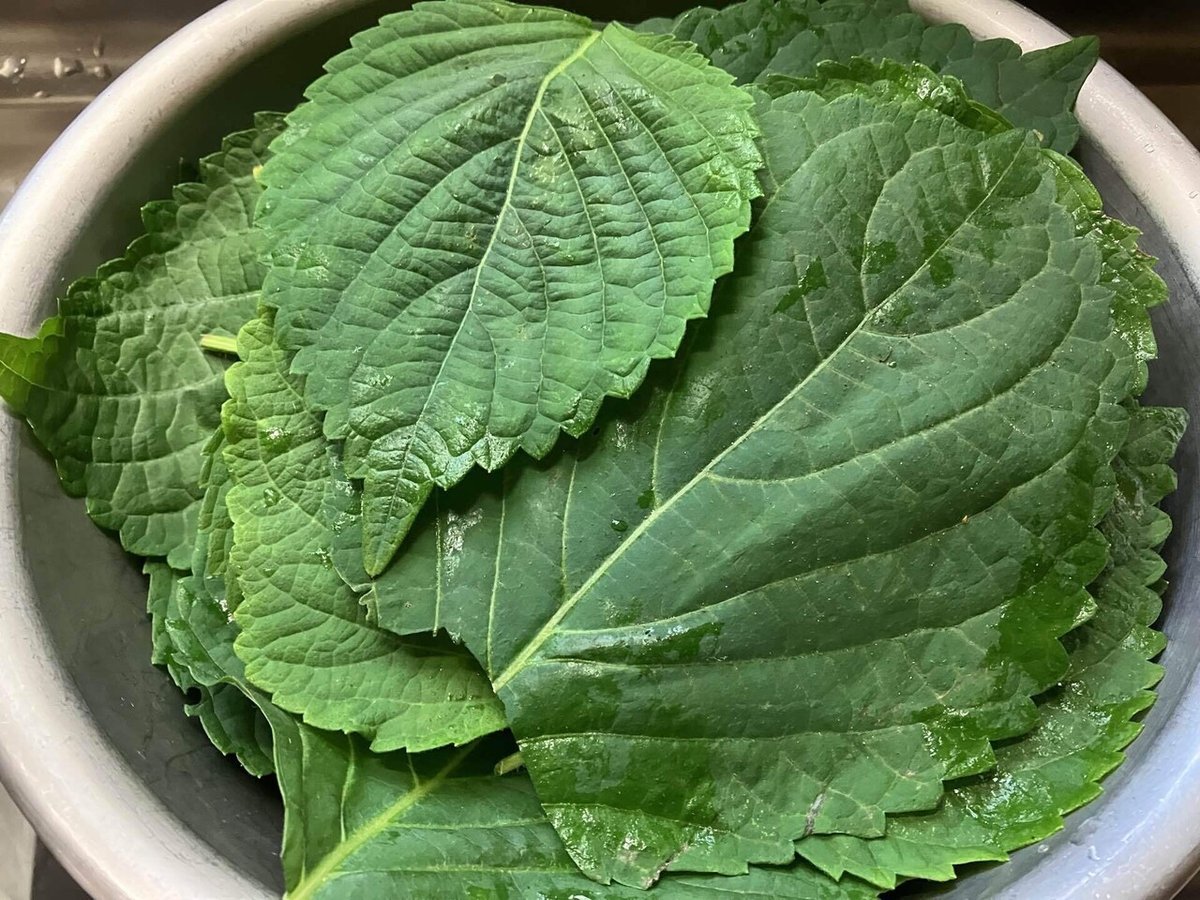
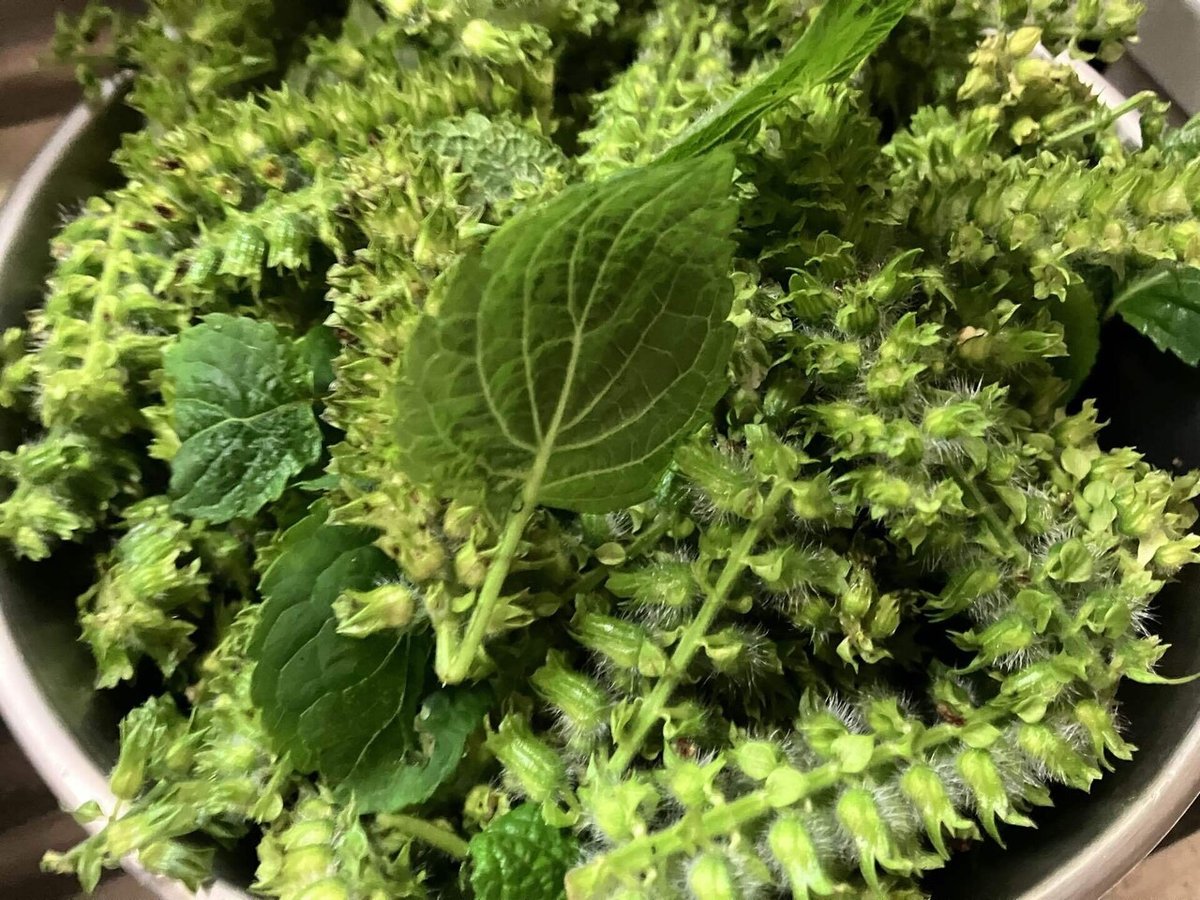
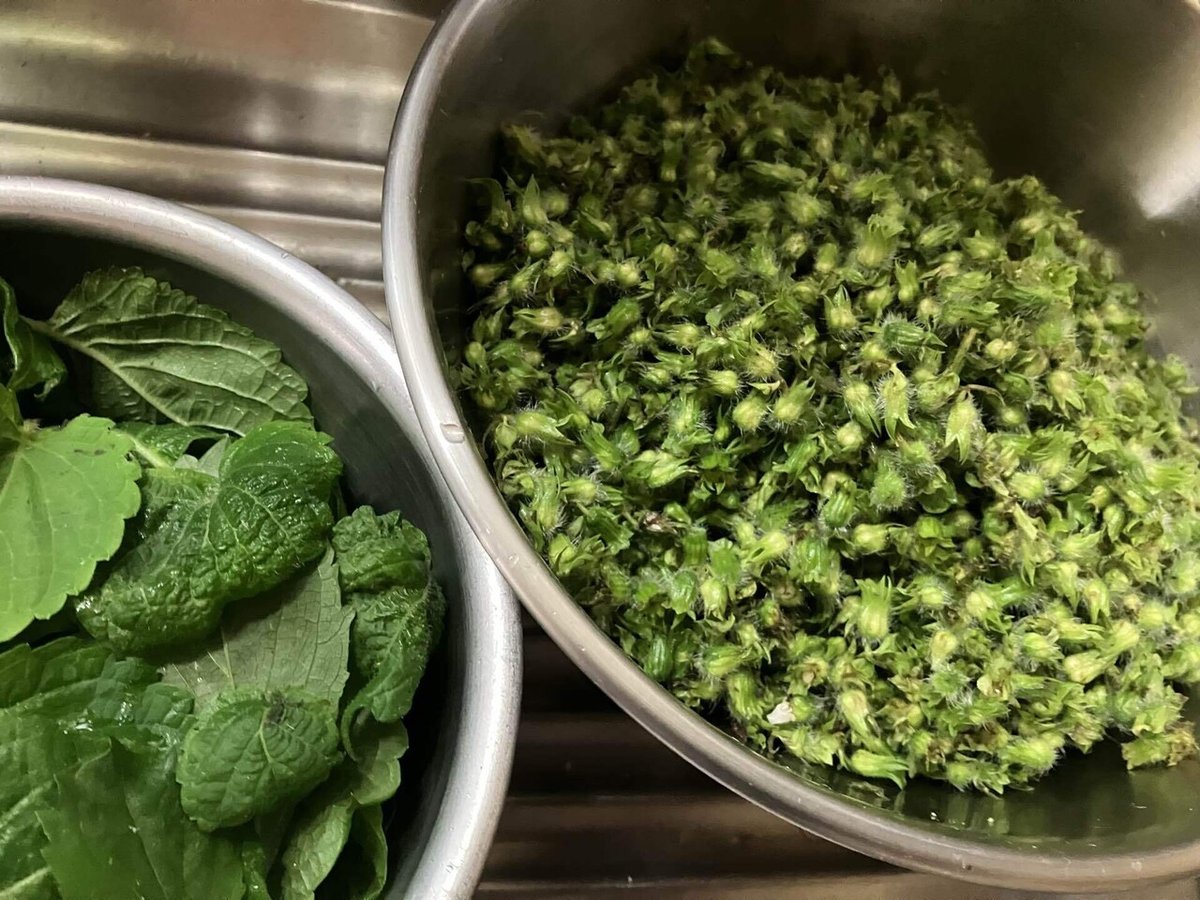
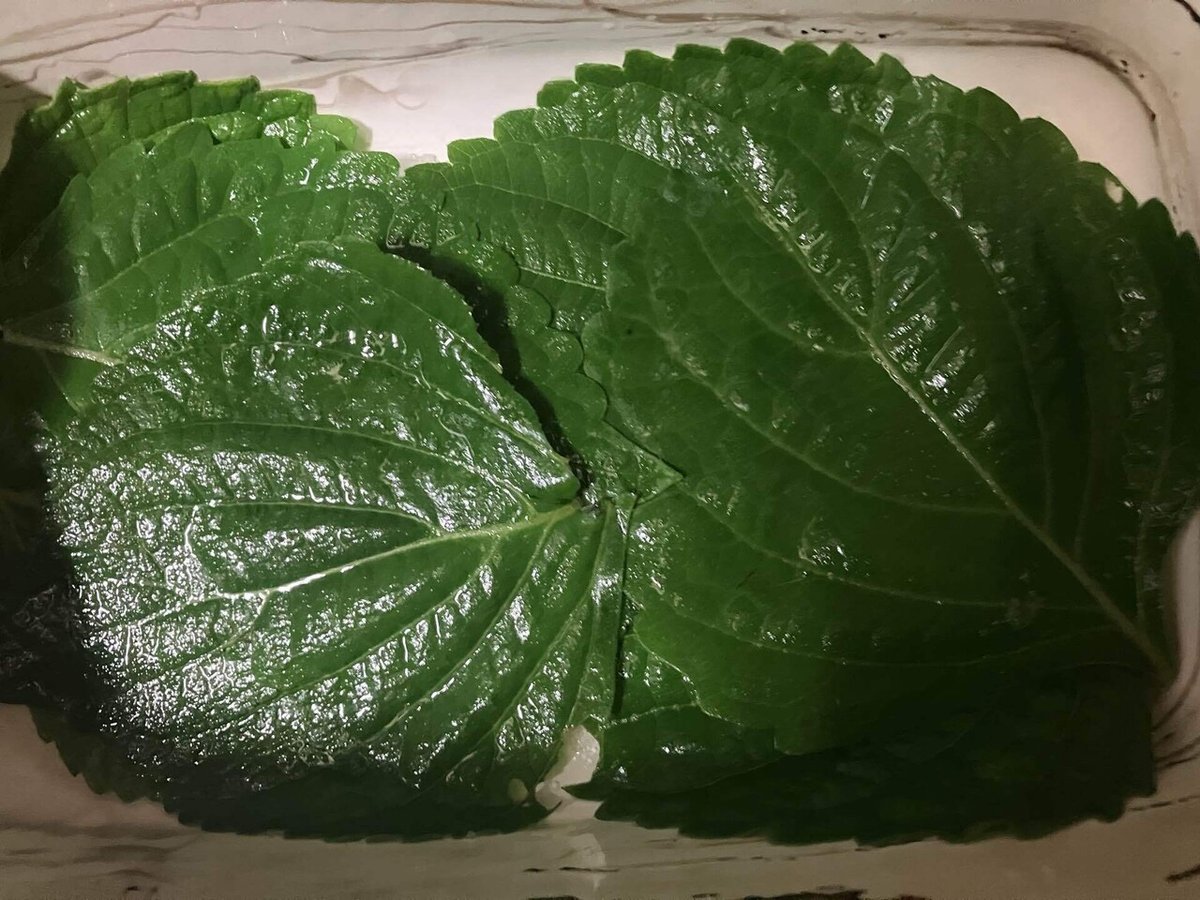
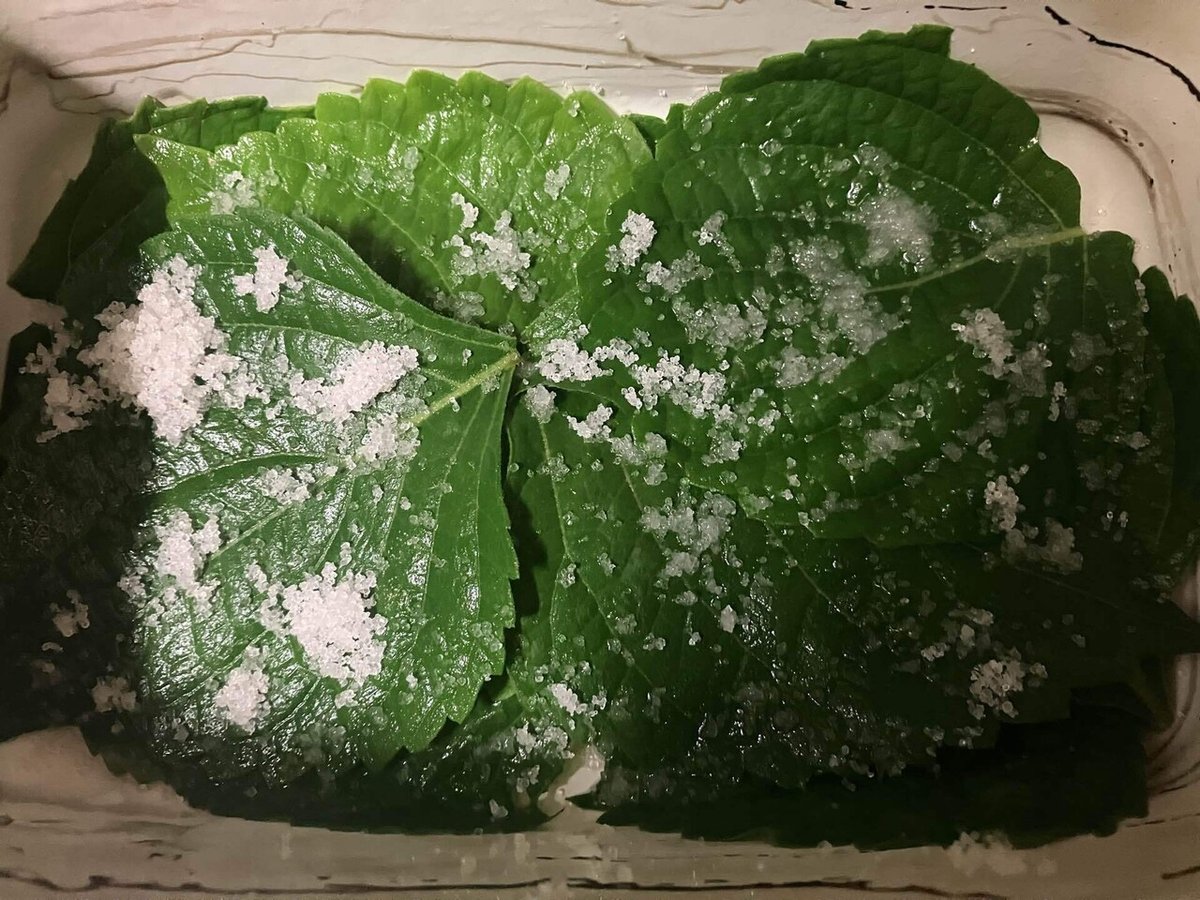
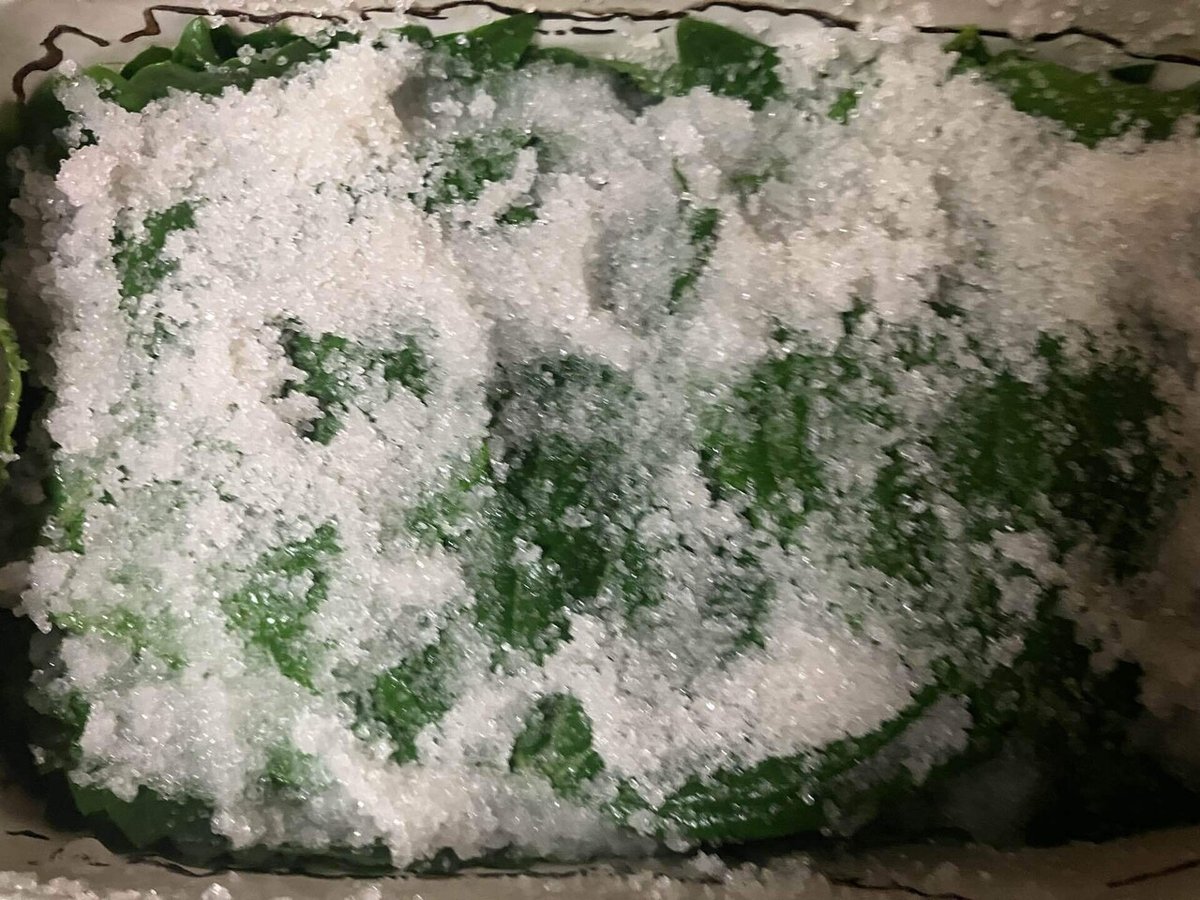
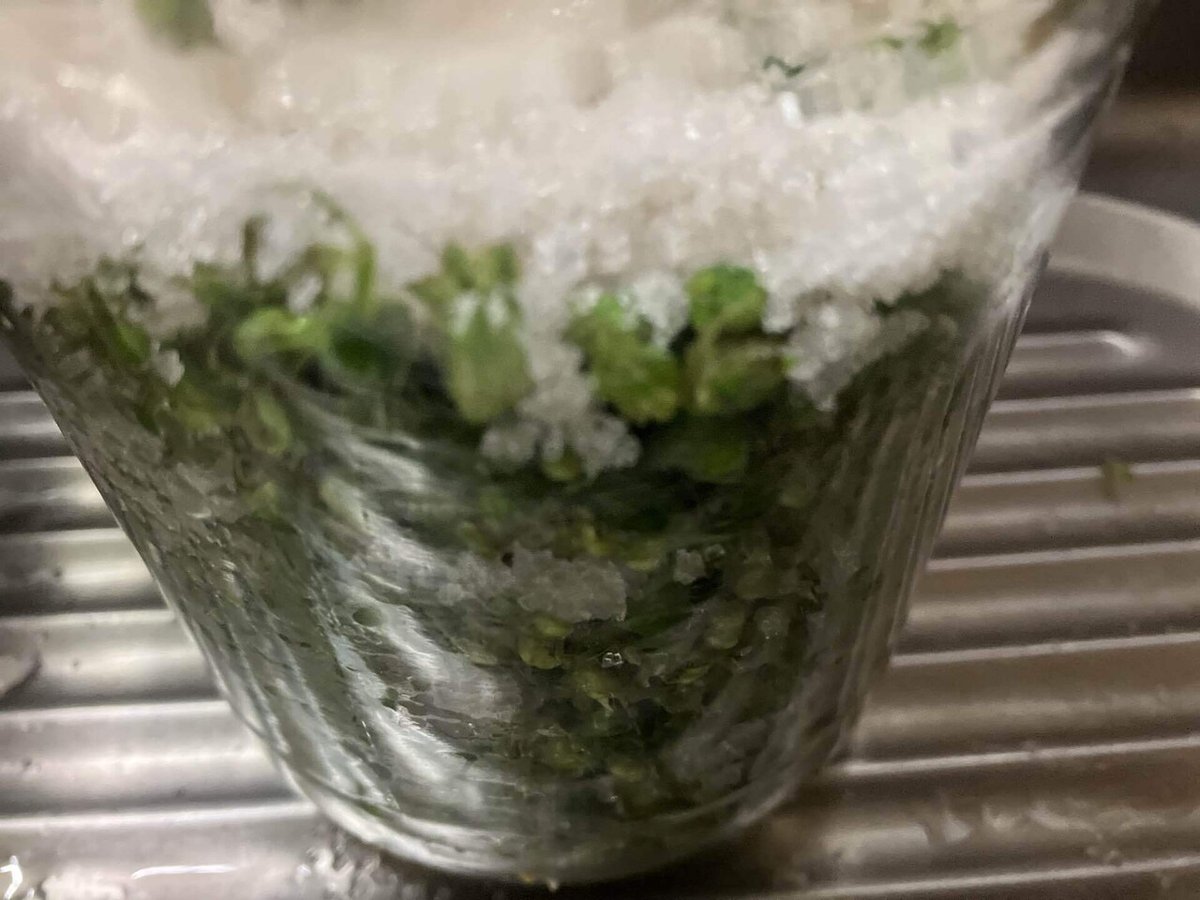
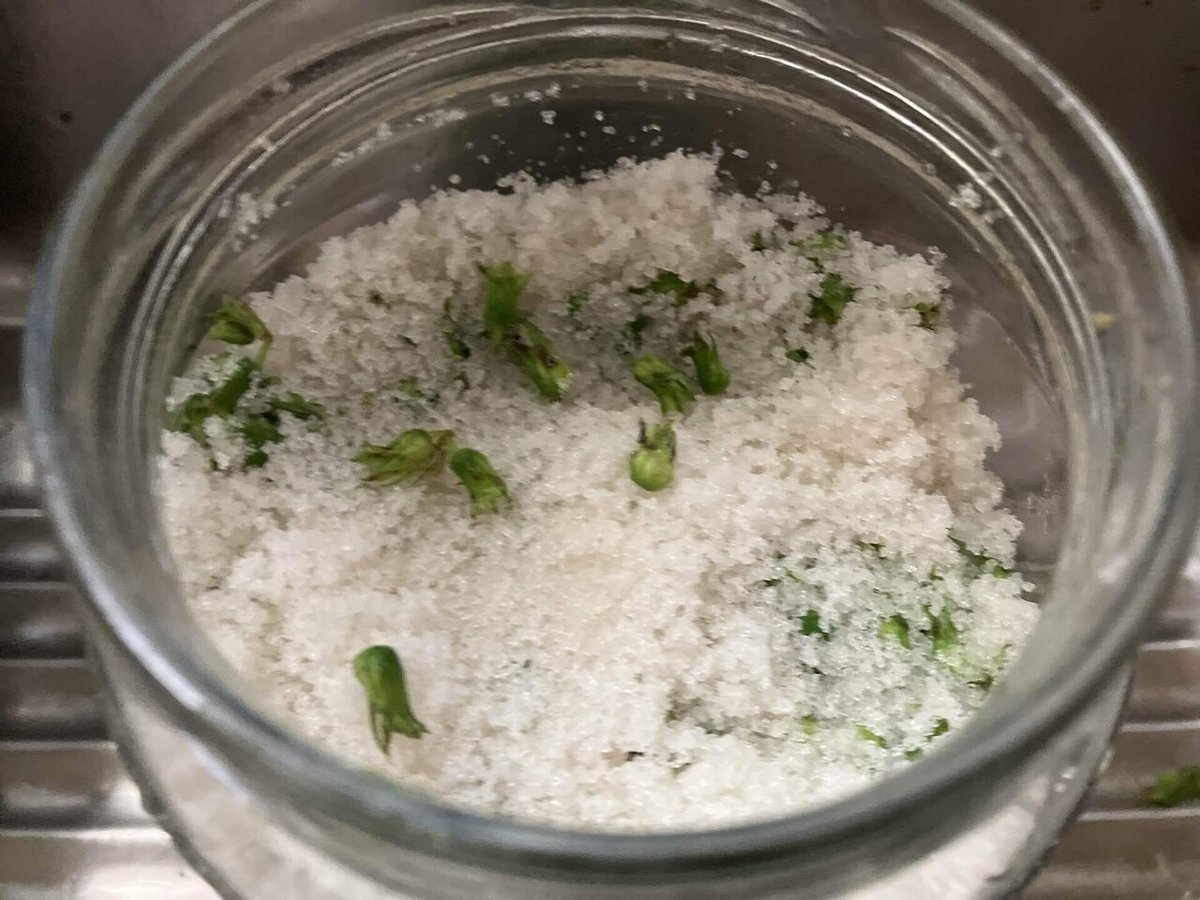
(出汁ガラと荏胡麻の実の佃煮)
昆布の出汁ガラを良く洗って、四角く切っておく。
椎茸の軸は石付きを切り取って、細く刻んでおく。
鍋に昆布、椎茸の茎、荏胡麻の実、青山椒の粒を入れて、薄口醤油と濃口醤油を半々に注ぎ、加熱する。
沸騰して来たら、焦がさないように、火を弱めて、絶えずかき混ぜる。
水気がなくなって来たら、火を止める。
消毒した瓶などに入れれば冷蔵庫で一月以上保存が可能。常温でも保存できるが、夏は冷蔵庫に入れた方が長持ちする。
(Tsukudani made with leftovers of dashi soup stock and perilla seeds)
Wash the kelp thoroughly and cut them into squares.
Cut off the stones from the shiitake mushroom stems and chop them finely.
Put the kelp, shiitake mushroom stems, perilla seeds, and green sansho peppercorns in a pot, pour in half light type soy sauce and half type dark soy sauce, and heat.
When it starts to boil, reduce the heat and stir constantly to prevent burning.
When the water has evaporated, turn off the heat.
If placed in a sterilized jar, it can be stored in the refrigerator for over a month. It can also be stored at room temperature, but it will last longer if stored in the refrigerator in summer.
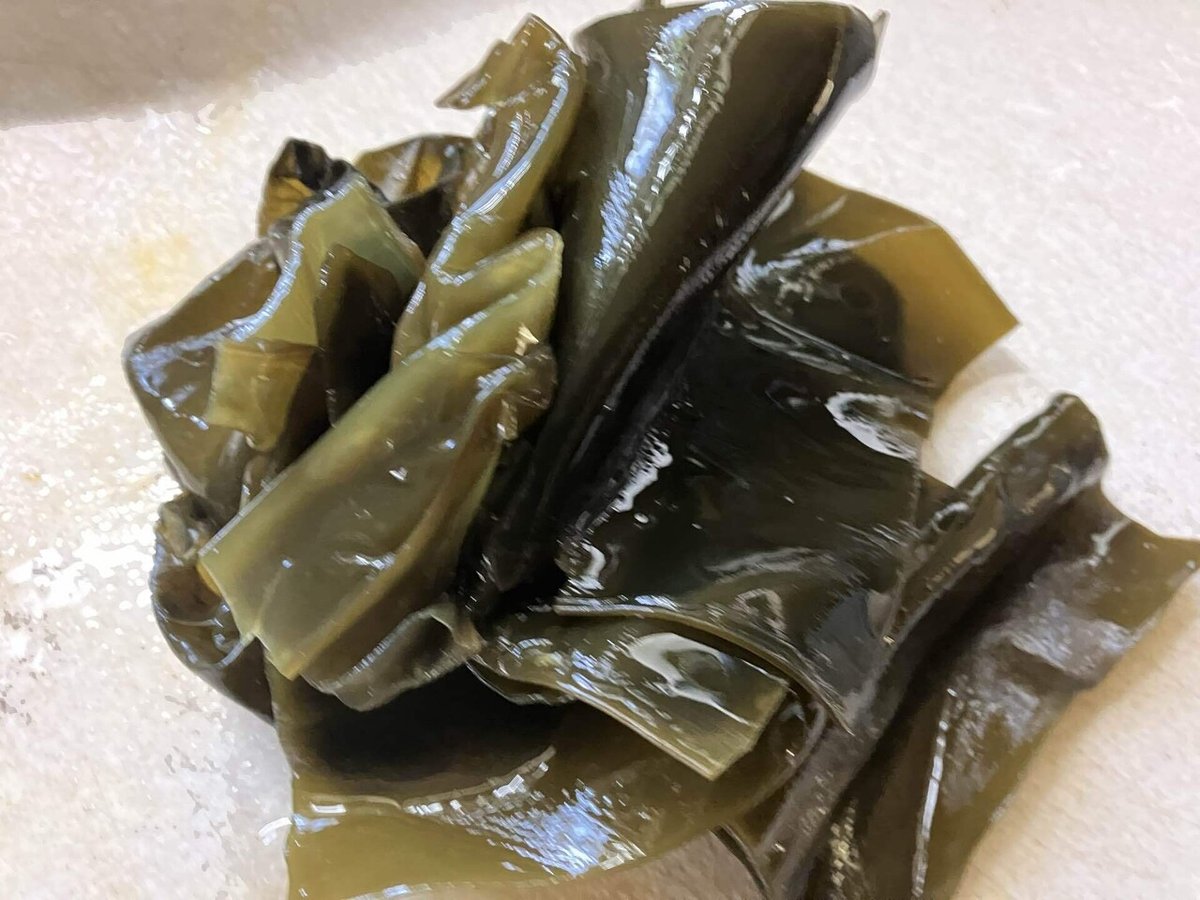
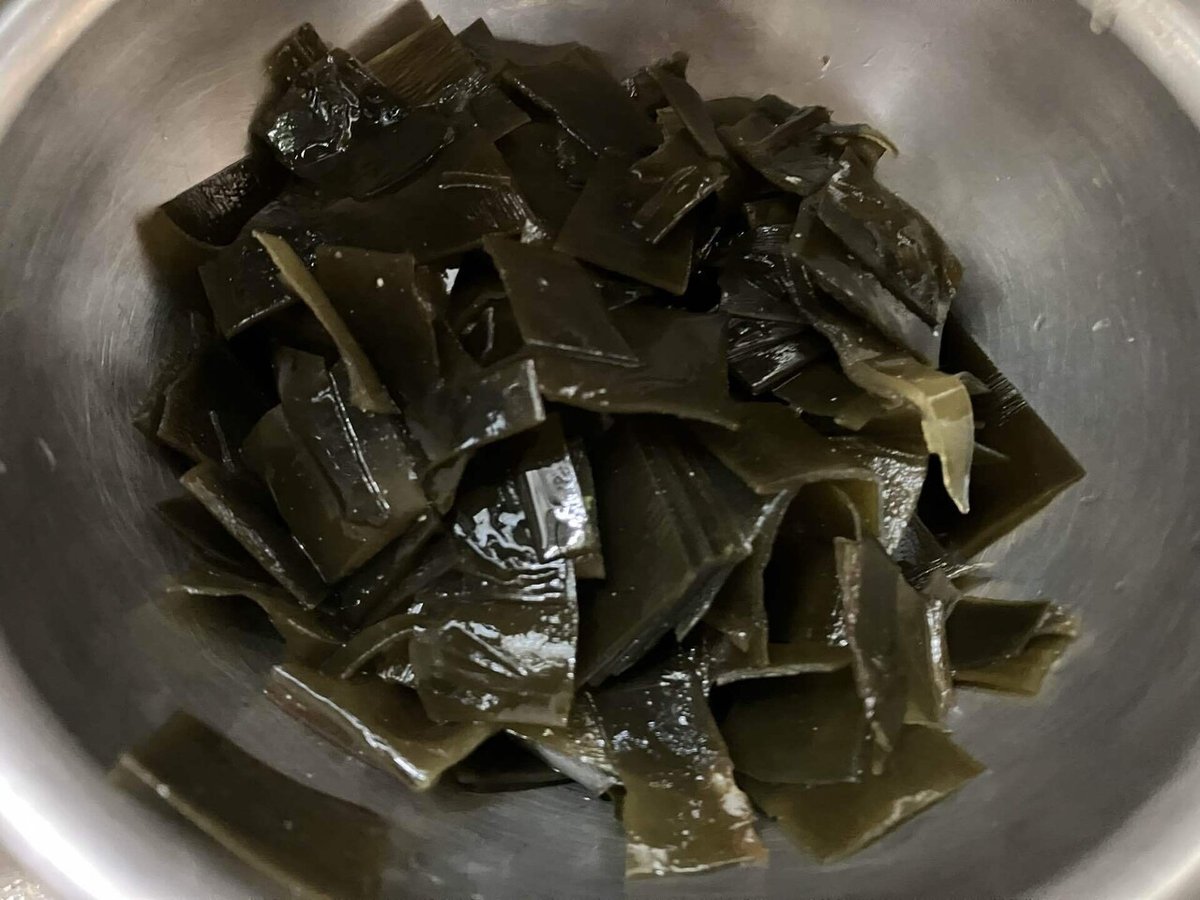
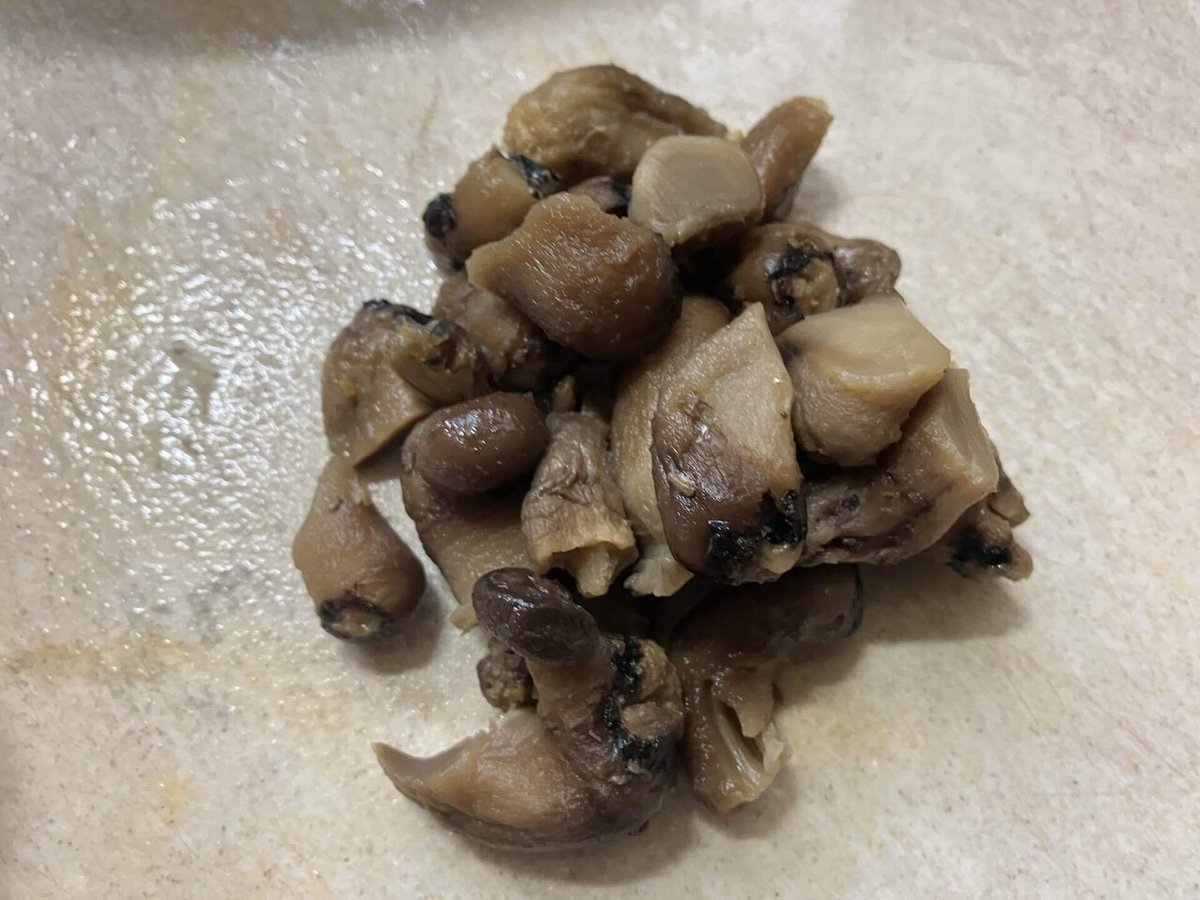
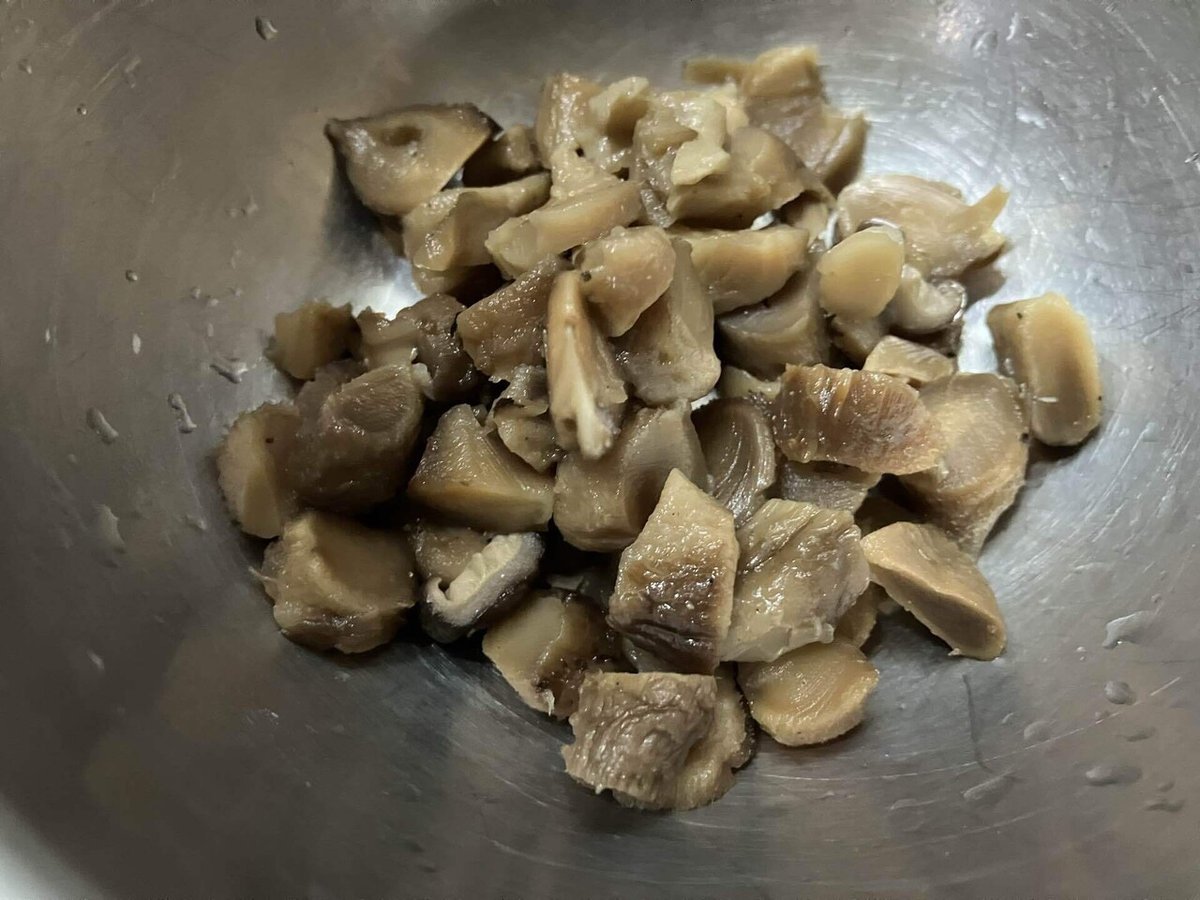
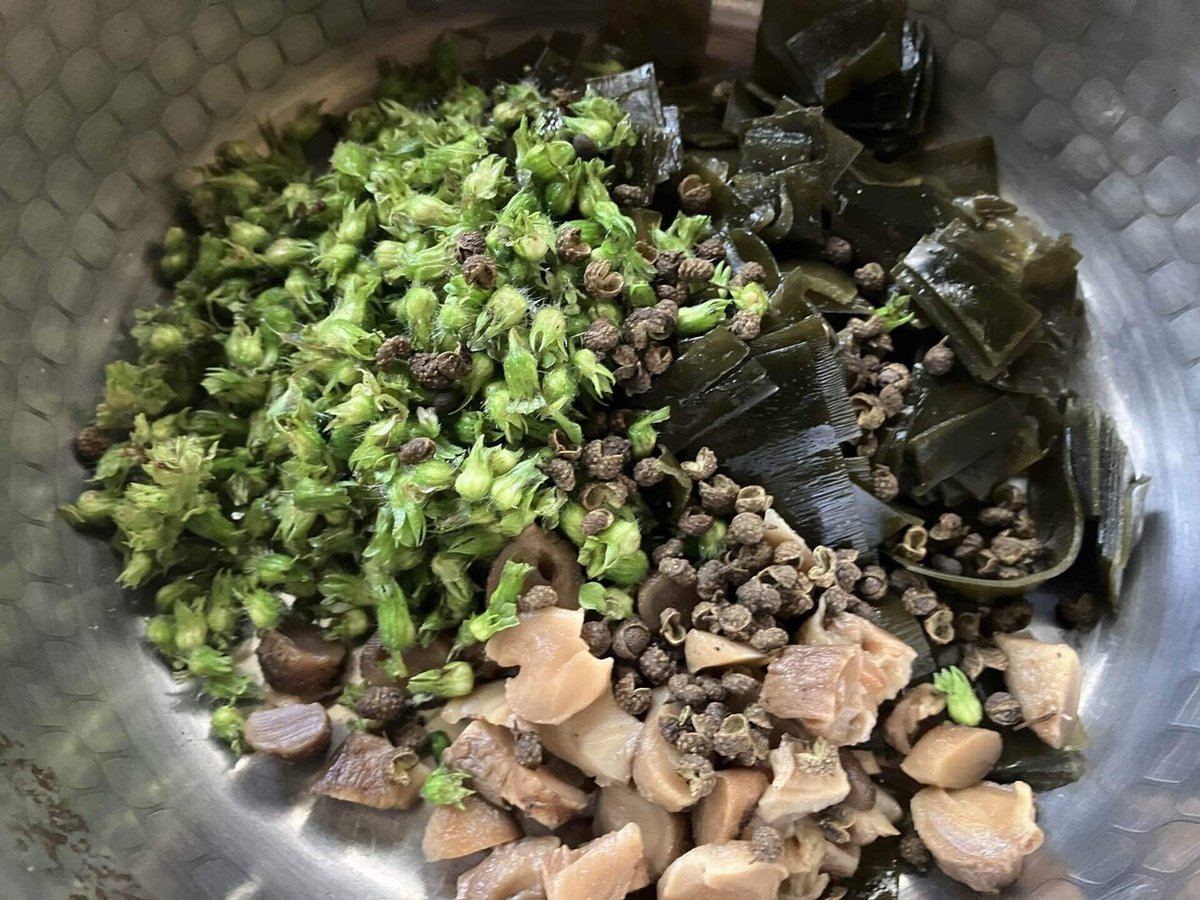
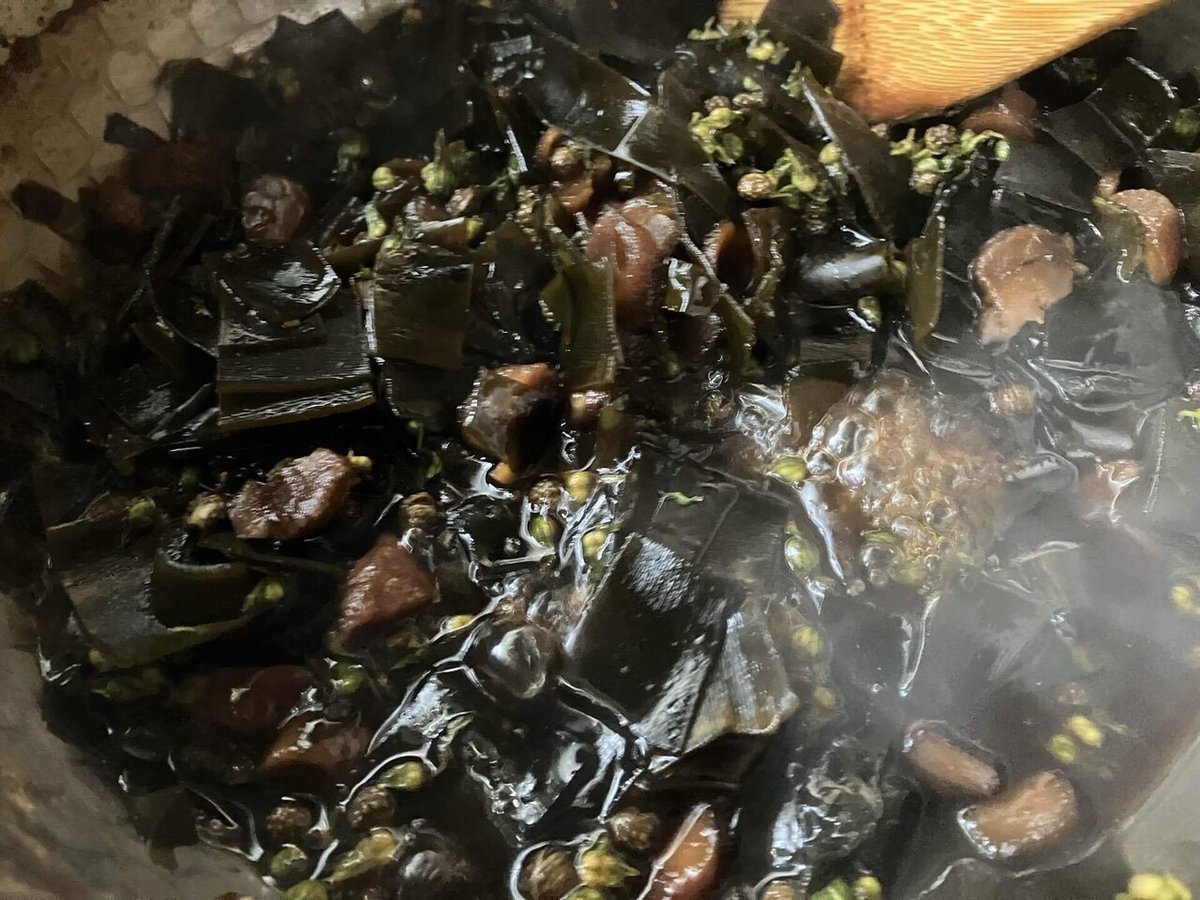
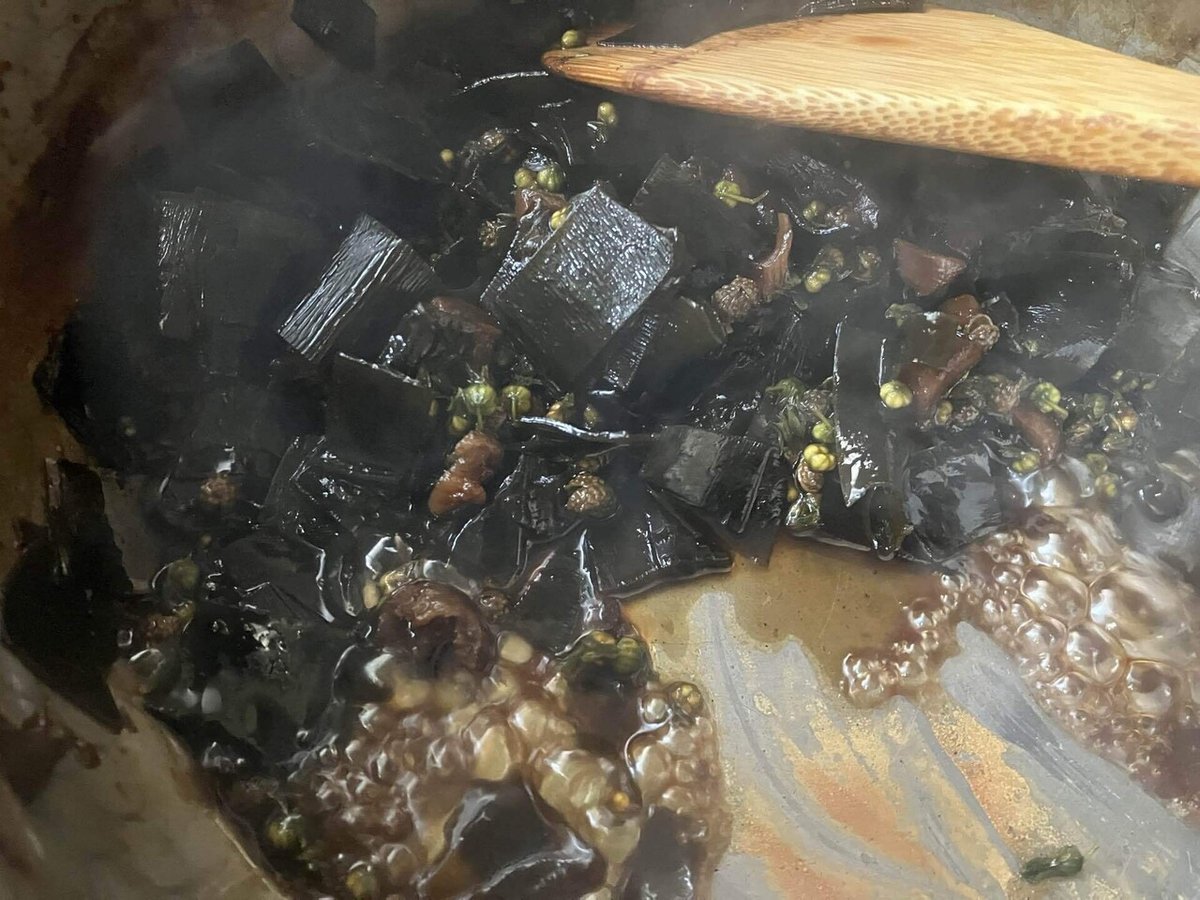
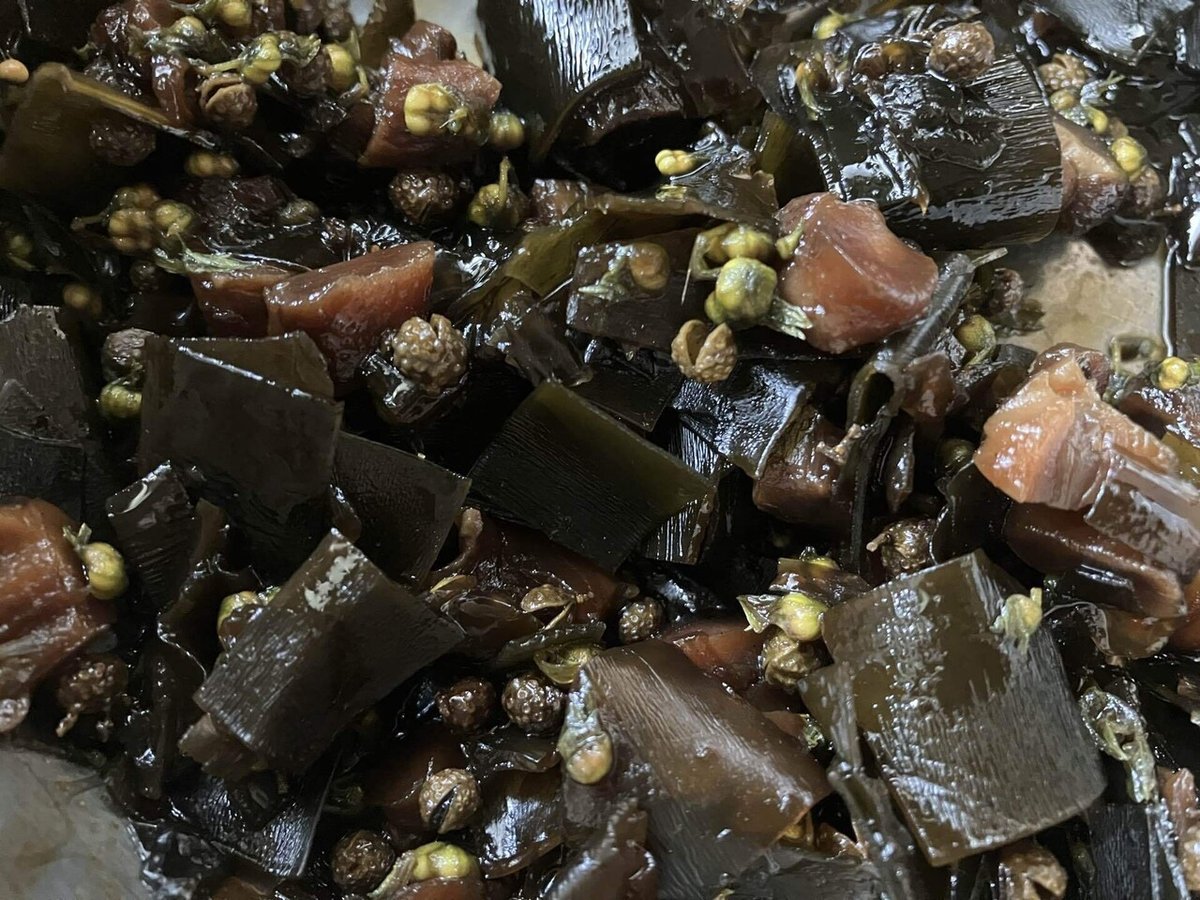
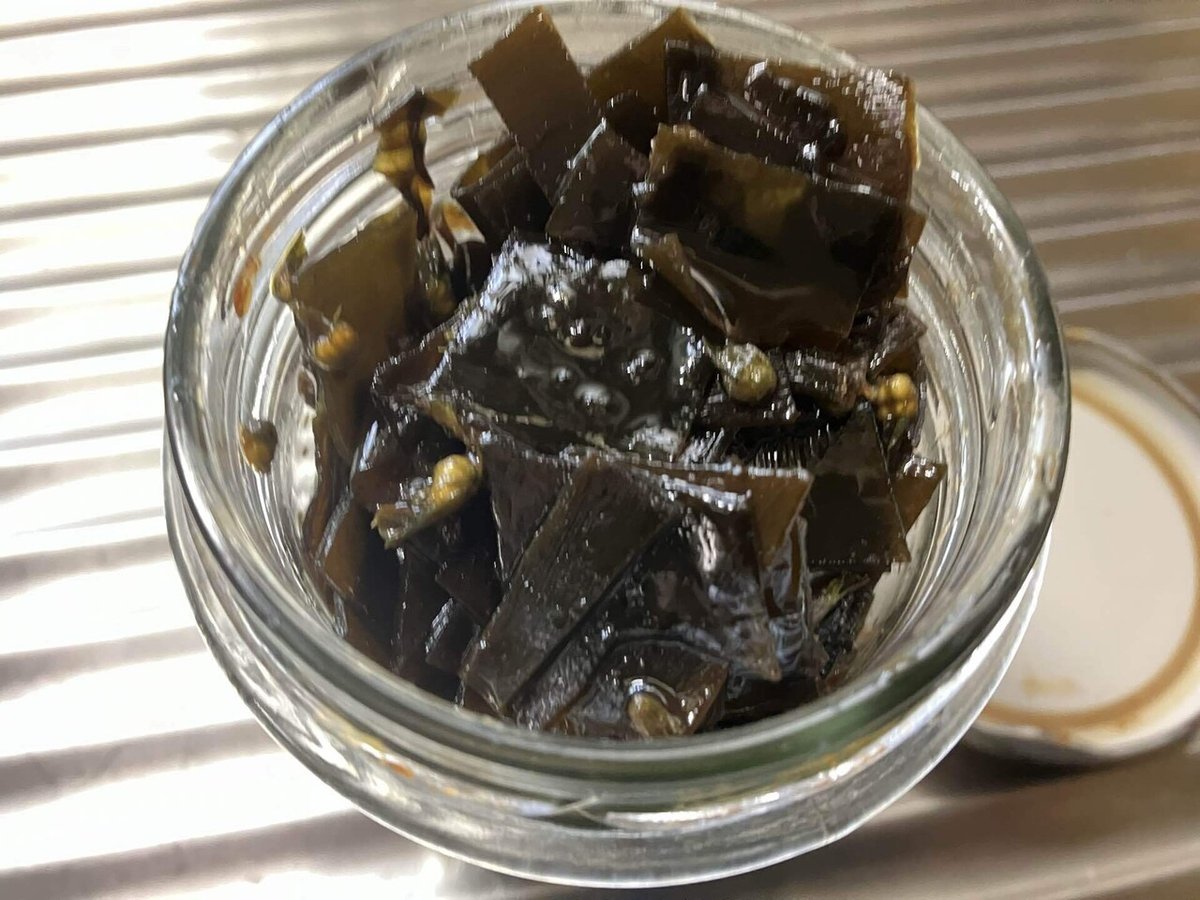
(仕舞いのお茶漬け)
冷やご飯に佃煮を乗せて、熱湯を注ぐ。
熱々が好みなら、冷やご飯に熱湯を注いでしばらくしてお湯を切って使うか、電子レンジなどで温めて使えば良い。
熱湯の代わりに、ほうじ茶や番茶を注いでも良い。
(Shimai Ochazuke)
Place the tsukudani on cold rice and pour boiling water over it.
If you like it hot, pour boiling water over the cold rice and drain it after a while, or you can warm it up in the microwave before using.
Instead of boiling water, you can also use roasted green tea or bancha tea.
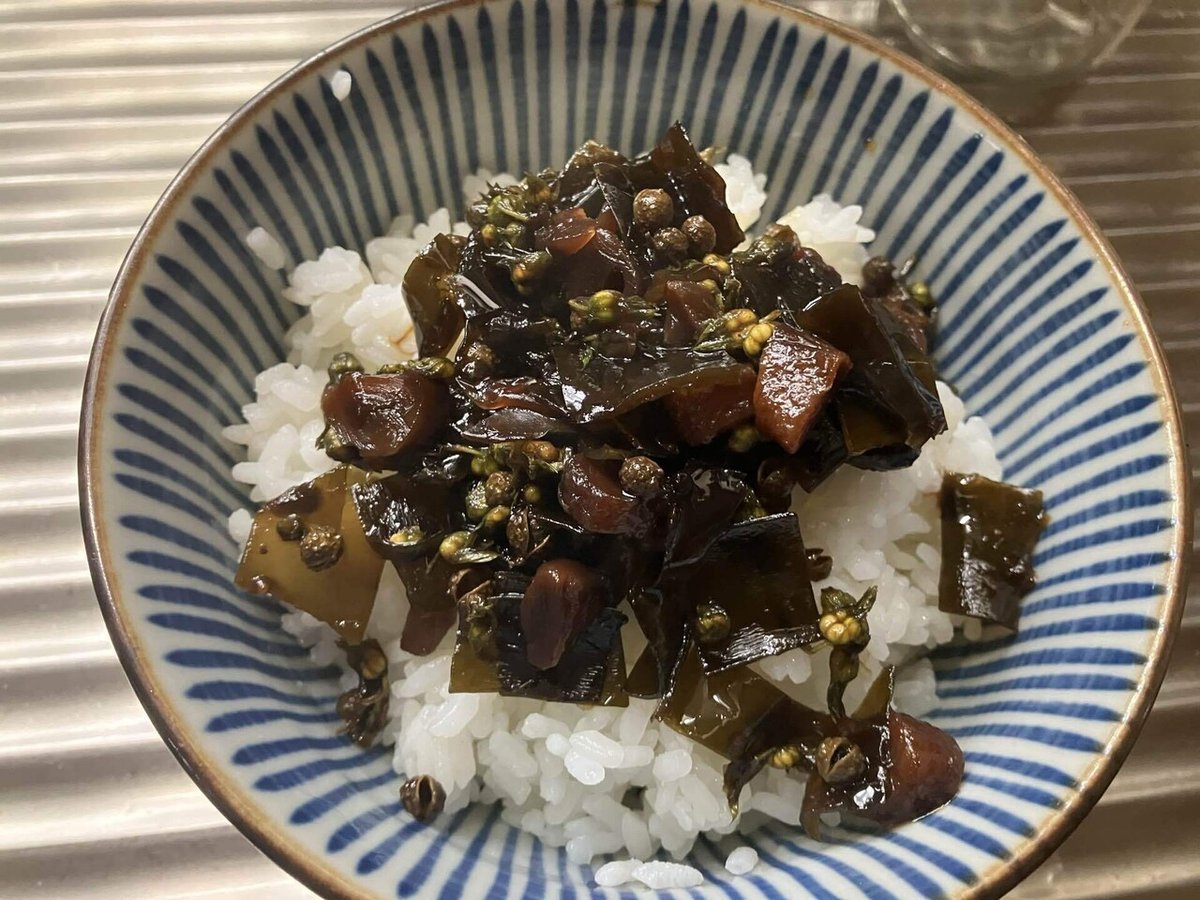
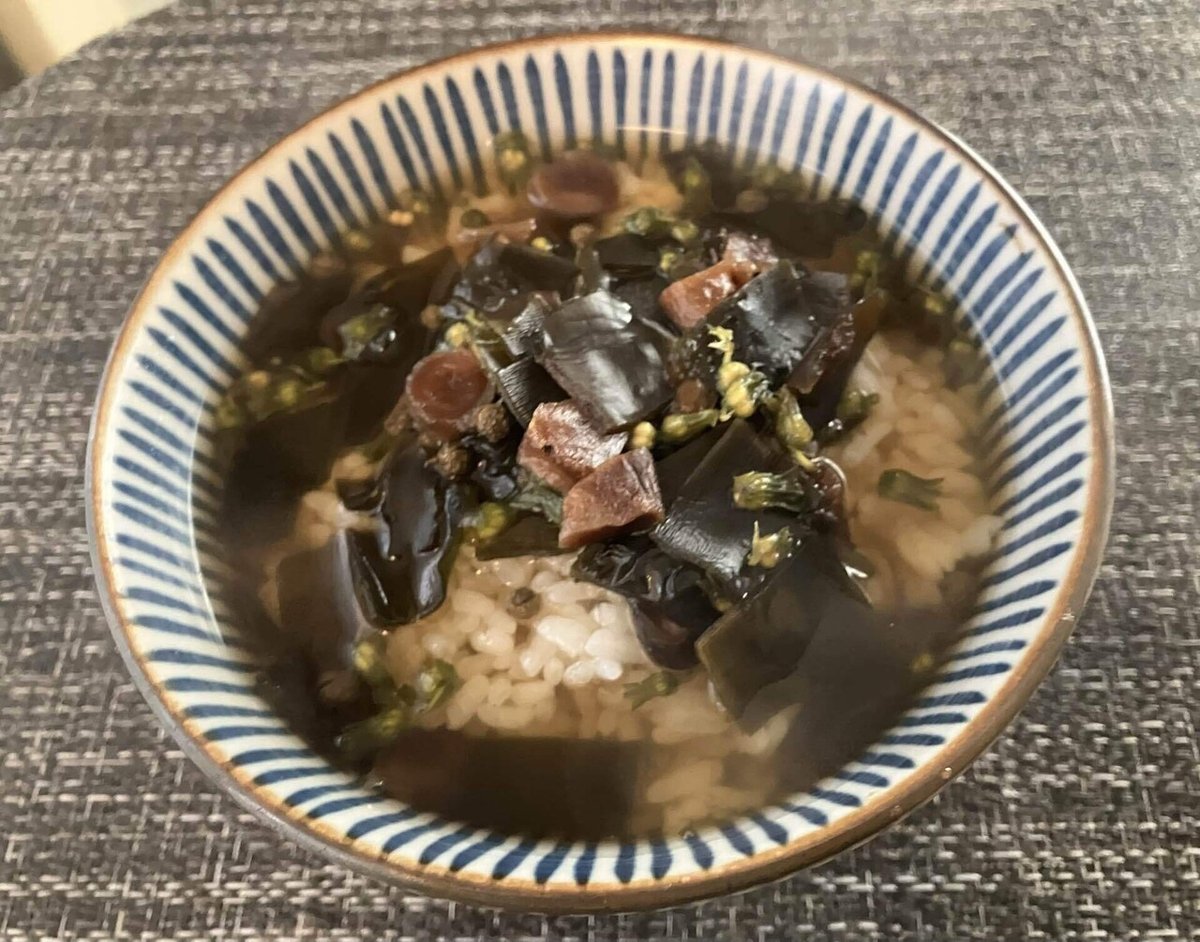
ヒントとバリエーション
Recipe tips and variation
僕のプランターの荏胡麻は期せずして紫蘇と混交しているので、一緒くたに処理しているが、塩漬けは荏胡麻で作っても紫蘇で作っても良い。
塩でつけた後水が上がってこない場合は、煮沸して冷ました濃い塩水を注いでも良い。塩水に浸かった状態でないとカビが生えてしまう。また、塩分の濃度が薄いと腐敗するので塩分濃度は十分濃くする(10パーセント以上)。
そんなにたくさん食べるものではないので、そのまま使っても良いが、塩分が気になるなら、使う時に、しばらく水に浸け塩抜きすれば良い。
葉の方はおにぎりや巻物に使ったり、ちらし寿司や押し寿司に使ったり、刻んで薬味にすると良い。韓国風に焼肉を巻いて食べるのもありだ。
実の方は、薬味で使うほか、おにぎりに握り込んだり、お茶漬けにすると良い。
僕は、いろいろな料理に応用できるよう、あえて塩漬けにしているが、途中で韓国風にしたいなら、一旦塩抜きしてから、にんにく醤油に付け直しても良い。キムチにすることもできる。
The perilla seeds in the planter are mixed with shiso by accident, so I'm processing them together, but you can pickle them with either perilla seeds or shiso.
If the water doesn't come out after salting, you can pour in concentrated salt water that has been boiled and cooled. If the seeds are not submerged in salt water, they will grow mold. Also, if the salt concentration is low, they will rot, so make sure the salt concentration is high enough (10% or more).
If you don't eat that so much, you can use them as they are, but if you are concerned about the salt, you can soak them in water for a while before using them to remove the salt.
The leaves can be used in rice balls or sushi rolls, in chirashi sushi or oshizushi, or chopped up and used as a condiment. You can also eat them wrapped around barbecued meat in the Korean style.
The fruit can be used as a condiment, or you can put it in rice balls or make it into ochazuke.
I salt them so that they can be used in a variety of dishes, but if you want to make them Korean style, you can desalt them and then soak them in garlic soy sauce. You can also make kimchi.
佃煮には水は入れないこと、腐りやすくなる。醤油だけ、あるいは酒や焼酎を足しただけで煮切るのが良い。
ここでは、貧乏人なので、高価な和山椒は使わず、中国産の乾燥青山椒を使っている。山椒を植えている人や余裕のある人は、もちろん和山椒を使えば良い。乾燥のものを使う時は、熟した赤花椒でなく、熟す前に収穫された青花椒を使う。その方が国産の山椒に味が近い。
昆布や椎茸の他、茎わかめ、煎り大豆(精進出汁を取る時に使ったもの)、割り干し大根、田作り、出汁を取って残った煮干しや鰹節を使っても良い。また灰汁の強い野蕗や明日葉などの野草も使える。
出汁の取り方については、以前の記事で説明しているので、よければご参照ください。
Do not add water to tsukudani, as it will spoil easily. It is best to boil it down using only soy sauce, or by adding only sake or shochu.
Here, since I am poor, I do not use expensive Japanese sansho pepper, but dried green sansho pepper from China. Of course, those who grow sansho pepper or have the means can use Japanese sansho pepper. When using dried sansho pepper, use green sansho pepper harvested before the vinegar seasoning, rather than ripe red flower sansho pepper. This will taste closer to domestically grown sansho pepper.
In addition to kelp and shiitake mushrooms, you can also use wakame stems, roasted soybeans (used to make the vegetarian soup), split dried daikon radish, rice crackers, dried sardines and bonito flakes left over from making soup stock. You can also use wild plants such as wild butterbur and ashitaba angelica, which have a strong astringency.
I have explained how to make dashi in a previous article, so please refer to it if you are interested.
お茶漬けには、佃煮のほか、刻んだ古漬けや梅肉を添えても良い。また、すり胡麻、刻み海苔、三つ葉などをトッピングすると豪華になる。
In addition to tsukudani, you can also add chopped aged pickled vegetable or umeboshi plum flesh to your ochazuke. You can also add ground sesame seeds, chopped nori seaweed, mitsuba (Japanese parsley) and other toppings to make it more luxurious.
漬物や糠漬けについては、以前の記事で詳しく書いているのでよければご参照ください。
I have written in detail about pickles and bran pickles in previous articles, so please feel free to refer to them.
Guide to where to get ingredients and equipment 材料と機材の入手先ガイド
※Amazonのアフェリエイトに参加しています。もしご購入の際はここからクリックしてご購入いただけると、コーヒー代の足しになるので、嬉しいです。ちなみに僕はコーヒー依存症です。
*I participate in Amazon affiliate programs. If you purchase this product by clicking here, it will help pay for my coffee, so I would be very happy. By the way, I am addicted to coffee.
